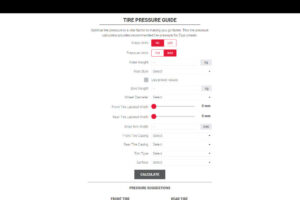Getting a wheel alignment is an essential part of car maintenance, but what about getting an alignment with bad tires? It’s a common question that many car owners have, and the answer may surprise you.
According to TireGrades, getting an alignment with bad tires is possible, but it’s not recommended.
The condition of your tires won’t affect how well the technician and the alignment machine can perform an alignment service accurately.
However, the alignment won’t hold for long due to the irregular wear and tear bad tires face.
While it’s technically possible to get an alignment with bad tires, it’s not a long-term solution.
Wheel Frenzy explains that getting an alignment with bad tires is akin to putting a band-aid on a bullet wound.
It doesn’t solve the underlying issue, and the alignment won’t hold for long due to the irregular wear and tear bad tires face.
If your tires have uneven wear, you likely need to have an alignment performed.
However, if your tires are worn smoothly and simply need to be replaced due to age or wear, there’s no real need to have an alignment performed.
It’s important to note that getting a wheel alignment is vital to ensure safe and efficient driving, prevent unnecessary wear on tires and other components, and save you money in the long run.
Bridgestone Tires explains that improper alignment can cause your tires to wear unevenly and prematurely, which can lead to a rough ride, poor handling, and decreased fuel efficiency.
Therefore, it is essential to keep your tires in good condition and get regular wheel alignments to ensure your car runs smoothly and safely.
Understanding Wheel Alignment

Wheel alignment is an essential aspect of car maintenance that involves adjusting the angles of the wheels to ensure they are perpendicular to the ground and parallel to each other. Proper alignment ensures that the car handles well, drives smoothly, and the tires wear evenly.
There are three main angles that technicians adjust during a wheel alignment: camber, toe, and caster. Camber refers to the inward or outward tilt of the wheels when viewed from the front of the car.
Toe is the angle of the wheels when viewed from above, and it determines whether the wheels are pointing inward or outward. Caster is the angle between the steering axis and the centerline of the wheel, and it affects the stability and handling of the car.
Improper alignment can result in uneven tire wear, a crooked steering wheel, and poor handling. It can also cause the car to pull to one side, making it difficult to drive in a straight line. Misaligned wheels can also put extra stress on suspension parts and components, leading to premature wear and tear.
It is possible to get an alignment with bad tires, but it is not recommended. Bad tires can affect the accuracy of the alignment, and the technician may not be able to adjust the angles properly. It is important to replace worn or damaged tires before getting an alignment to ensure the best results.
The Impact of Bad Tires on Alignment
Bad tires can cause a range of problems, including affecting the alignment of your vehicle. However, this doesn’t mean that you can’t get an alignment with bad tires. In fact, the condition of your tires won’t have any effect on how well the technician and the alignment machine will be able to perform an alignment service accurately.
That said, it’s important to understand that bad tires can lead to misalignment, which can cause uneven tire wear, excessive tire wear, and other issues. Misalignment occurs when the angles of the wheels are not set correctly, causing the tires to wear unevenly. This can lead to a range of problems, including reduced fuel efficiency, poor handling, and even unsafe driving conditions.
Worn tires can also cause misalignment, as they can affect the suspension and steering components of your vehicle. If your tires are worn, it’s important to replace them before getting an alignment. This will ensure that your vehicle is properly aligned and that your tires will wear evenly.
It’s also worth noting that certain types of tires can affect alignment. For example, if you have different types of tires on your vehicle, this can cause misalignment. Additionally, if your tires are not properly inflated, this can also affect alignment. It’s important to regularly check your tire pressure and ensure that all of your tires are properly inflated.
Signs of Misalignment

Misaligned wheels can cause a variety of problems for your vehicle, including uneven tire wear and handling issues. Here are some common signs that your wheels may be misaligned:
Steering Wheel Off-Center
One of the most obvious signs of misalignment is an off-center steering wheel. If you’re driving straight down the road and your steering wheel is not centered, it’s likely that your wheels are misaligned. This can be caused by a variety of factors, including hitting a curb or pothole.
Vehicle Pulling to One Side
If your vehicle is pulling to one side while you’re driving, it’s a good indication that your wheels are misaligned. This can be caused by uneven tire wear or a variety of other factors. It’s important to get your wheels aligned as soon as possible to prevent further damage to your tires and suspension system.
Uneven Tire Wear
Misaligned wheels can cause your tires to wear unevenly. This can lead to premature tire wear and the need for replacement tires sooner than expected. If you notice that your tires are wearing unevenly, it’s important to get your wheels aligned as soon as possible.
Vibration
If you feel a vibration in your steering wheel while you’re driving, it’s possible that your wheels are misaligned. This vibration can be caused by a variety of factors, including uneven tire wear and misaligned wheels. It’s important to get your wheels aligned as soon as possible to prevent further damage to your tires and suspension system.
Causes of Misalignment
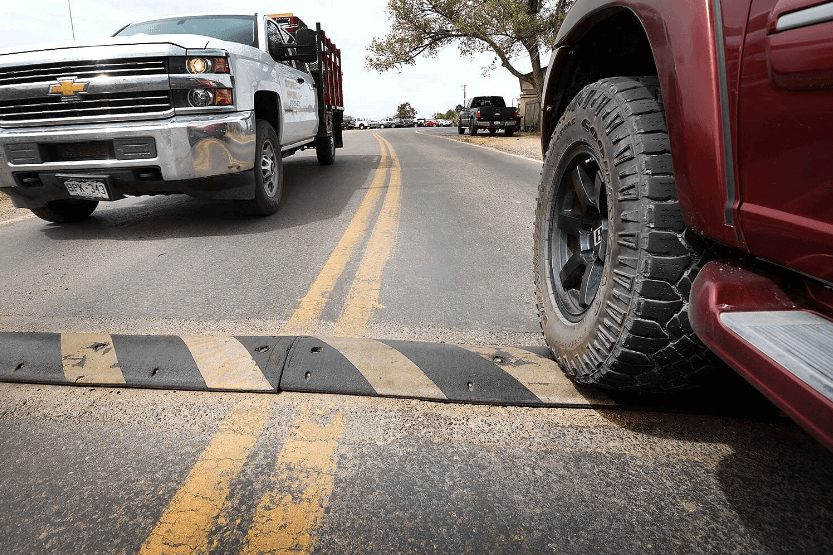
There are various reasons why a vehicle’s wheels can become misaligned. Here are some of the most common causes:
- Time and normal wear and tear: Over time, the suspension parts of a vehicle can wear out, causing the wheels to become misaligned. This is especially true for older vehicles that have not had regular maintenance.
- Accidents: Even a minor collision can throw off the alignment of the wheels. A major accident can cause more serious damage to the suspension system, leading to misalignment.
- Potholes, curbs, and road debris: Driving over potholes, hitting curbs, or encountering road debris can cause the wheels to become misaligned. This is because the impact can damage the suspension system or knock the wheels out of alignment.
- Speed bumps and off-roading: Driving over speed bumps or going off-roading can also cause misalignment. The impact of going over bumps and uneven terrain can damage the suspension system and throw the wheels out of alignment.
It is important to note that misaligned tires can cause a number of problems, including uneven tire wear, decreased fuel efficiency, and poor handling. Therefore, it is important to have your vehicle’s alignment checked regularly, especially if you frequently encounter any of the above causes of misalignment.
Role of Suspension System
The suspension system of a vehicle is responsible for providing a smooth and comfortable ride by absorbing the shocks and vibrations produced by the road surface. It consists of several components such as tie rods, ball joints, control arms, and bushings, which work together to keep the wheels in proper alignment and ensure that the vehicle handles properly.
When a vehicle’s tires are out of alignment, it can cause uneven tire wear and affect the handling of the vehicle. This is because the suspension system is designed to work with the tires in a specific way, and when the tires are not aligned, it can put additional stress on the suspension components, causing them to wear out more quickly.
If a vehicle has bad tires, it is still possible to get an alignment, but it may not be as effective as it would be with new tires. This is because bad tires can affect the way the suspension system works, making it more difficult to achieve proper alignment.
In some cases, a bad tire can even cause damage to the suspension components, such as the tie rods or ball joints. This is because the tire is not able to absorb the shocks and vibrations as effectively as it should, putting additional stress on the suspension system.
Effects of Misalignment on Vehicle
Misaligned wheels can cause several problems for a vehicle. When the wheels are not correctly aligned, they will not point in the same direction, causing uneven tire wear. This can lead to a shorter tire life and a need for replacement tires sooner than expected.
Additionally, misaligned wheels can cause a decrease in fuel economy. When the wheels are not aligned, the tires will not roll as smoothly, causing the engine to work harder and use more fuel. This can lead to a decrease in overall efficiency and an increase in fuel costs.
In terms of safety, misaligned wheels can cause a vehicle to handle poorly. This can lead to difficulty in steering, especially at high speeds. In extreme cases, this can cause a loss of control of the vehicle, leading to accidents.
Modern vehicles are designed to have precise wheel alignment specifications. When the wheels are not aligned correctly, the vehicle’s overall performance can suffer. This can lead to a decrease in the vehicle’s handling, acceleration, and braking abilities.
Finally, misaligned wheels can cause additional wear and tear on the vehicle’s suspension components. This can lead to the need for costly repairs and replacements.
Wheel Alignment Services
Wheel alignment is an essential maintenance task that ensures that your vehicle’s wheels are perpendicular to the ground and parallel to each other. Proper alignment is vital for optimal tire wear, handling, and a smooth ride. If your vehicle has bad tires, you may wonder if you can still get an alignment service. The answer is yes; you can get an alignment with bad tires.
Alignment services are performed by trained technicians who use specialized equipment to adjust the angles of the wheels. The condition of your tires will have no effect on how well the technician and the alignment machine will be able to perform an alignment service accurately. However, if your tires are severely worn or damaged, you may need to replace them before getting an alignment service.
If you need new tires, it’s best to get them before getting an alignment service. New tires will ensure that your vehicle’s alignment is accurate and that the tires wear evenly. Some alignment services may require you to purchase new tires before they perform the service. Therefore, it’s essential to check with the alignment service provider beforehand.
When getting an alignment service, it’s essential to make an appointment. Many alignment services require an appointment to ensure that they have enough time to perform the service accurately.
During the appointment, the technician will inspect your vehicle’s suspension and steering components to ensure that they’re in good condition. After the inspection, the technician will use the alignment machine to adjust the angles of the wheels.
Once the alignment service is complete, the technician will provide you with a printout that shows the before and after measurements of the wheel angles. This printout will help you understand the adjustments made and ensure that the alignment service was performed accurately.
Many alignment services offer a warranty on their work, so be sure to ask about the warranty before getting the service.
Some popular alignment services providers include Firestone and Les Schwab. These providers offer alignment services for various types of vehicles, including cars, trucks, and SUVs. They also offer alignment services for vehicles with new tires, alignment after replacing one tire, and other alignment-related services.
To Summarize
In summary, it is possible to get an alignment with bad tires. The condition of the tires will not affect the technician’s ability to perform an accurate alignment service. However, it is important to note that bad tires can cause irregular wear and tear, which can lead to alignment problems.
Getting an alignment with bad tires is not a long-term solution. It is akin to putting a band-aid on a bullet wound. While it may temporarily solve the issue, the alignment won’t hold for long due to the irregular wear and tear bad tires face.
It is important to consider the lifespan of the tires when deciding whether to get an alignment with bad tires. If the tires are close to the end of their lifespan, it may not be worth the cost of the alignment. On the other hand, if the tires are relatively new and have a lot of life left, it may be worth getting an alignment to prevent further damage and costly repairs down the road.
Additionally, it is important to consider the road conditions the vehicle will be driving on. If the roads are rough or uneven, it may be more difficult to maintain proper alignment with bad tires. In this case, it may be best to replace the tires before getting an alignment.
Finally, it is important to note that tire balancing is also crucial for proper alignment. If the tires are not balanced properly, it can cause uneven wear and tear, which can lead to alignment problems. It is recommended to get tire balancing done at the same time as an alignment to ensure optimal performance.
Overall, it is important to weigh the costs and benefits of getting an alignment with bad tires. While it is possible, it may not be the best long-term solution. It is recommended to replace bad tires before getting an alignment to ensure optimal performance and prevent costly repairs in the future.

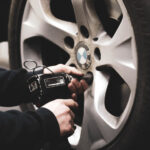
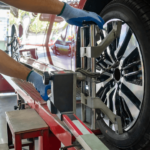
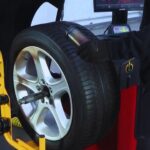
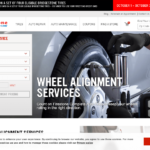
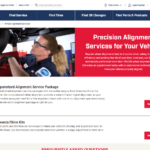
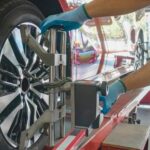
![Read more about the article Wheel Bearing Replacement Cost [Front or Rear]](https://roadsumo.com/wp-content/uploads/2021/04/wheel-bearing-replacement-cost-300x200.jpg)

